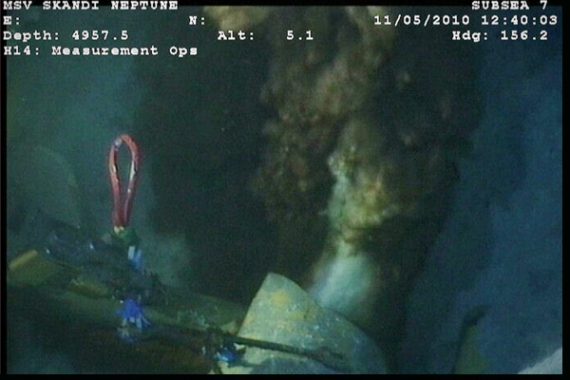Maybe The Gulf Oil Didn’t Go Away After All
It's beginning to look like initial reports that the Gulf of Mexico oil spill had been "cleaned up" may not be true after all.
There are multiple reports out today indicating that initial reports that the oil from the Deepwater Horizon disaster had largely disappeared from the Gulf of Mexico may not be true at all, and that we could be looking at a massive environmental disaster beneath the sea:
Academic scientists are challenging the Obama administration’s assertion that most of BP’s oil in the Gulf of Mexico is either gone or rapidly disappearing — with one group Thursday announcing the discovery of a 22-mile “plume” of oil that shows little sign of vanishing.
That plume was measured in late June and was described Thursday by scientists from Woods Hole Oceanographic Institution in Massachusetts. The biggest news was not the plume itself: For weeks, government and university scientists have said that oil from BP’s damaged well is still underwater.
The news was what is happening — or not happening — to it.
The scientists said that when they studied it, they saw little evidence that the oil was being rapidly consumed by the gulf’s petroleum-eating microbes. The plume was in a deep, cold region where microbes tend to work slowly.
“Our data would predict that the plume would still be there now,” said Benjamin Van Mooy, a Woods Hole researcher.
Their research came after a week in which other scientists had taken issue with the government’s portrait of where all the oil went. On Thursday afternoon, Jane Lubchenco, the Oceanic and Atmospheric Administration’s administrator, defended the government’s work, saying it was done by the “best scientific minds” and reviewed by outsiders.
(….)
Testifying before a House subcommittee Thursday, Florida State University professor Ian R. MacDonald called the administration’s account “misleading.” He said that the government’s assumptions about how much oil is breaking down underwater were too optimistic and that its report didn’t mention the natural gas that gushed out of BP’s Macondo well along with the oil.
“This oil is going to be in the environment for a long time. I think that the imprint of the BP release, the discharge, will be detectable in the Gulf of Mexico for the rest of my life,” said MacDonald, who is 58.
In that hearing, Rep. Edward J. Markey (D-Mass.) criticized a NOAA scientist for saying that the agency might wait two months before releasing the full details of the methodology it used to calculate what happened to the oil. “That is, to me, unacceptable. We need to have that information,” he said.
The report was also challenged this week by a group of Georgia academics. They questioned the government’s inclusion in its pie chart of the 17 percent of the oil that emerged from the well but never entered the gulf. It was, instead, siphoned directly to the surface. By including the amount in the official chart, they said, the government seemed to take credit for cleaning up oil that never spilled.
In addition, the Georgia group said the government was overly optimistic in reporting that about 25 percent of the oil either evaporated or dissolved.
“The vast majority of this oil never got to the surface, so it couldn’t have evaporated,” said Charles S. Hopkinson, a professor in the department of marine sciences at the University of Georgia. Federal officials disagree, estimating that four-fifths of the oil rose to the surface.
The real answer here seems to be that nobody is entirely sure what happened with all the oil that was spewing out of the floor of the Gulf of Mexico for three months. At the very least, the assertion by the Obama Administration and BP that the vast majority of it made it’s way to the surface and either evaporated or was captured doesn’t seem to comport with the evidence that we have.
One wonders if the Administration’s declaration that the oil was gone will turn out to be it’s own version of “Mission Accomplished.”







“At the very least, the assertion by the Obama Administration and BP that the vast majority of it made it’s way to the surface and either evaporated or was captured doesn’t seem to comport with the evidence that we have.”
“Vast majority” is a somewhat imprecise term but it actually does comport with the evidence we have if we assume the majority to be say 60% plus. The Woods Hole survey btw is two months old as they admit and there was a largely ignored upside to it in that there has not been anything like the oxygen depletion in the area that they were anticipating. Obviously the media are intent in maintaining the hysteria they’ve displayed over this whole issue from the star tfor as long as they can so they’ve now moved on to “the govt is lying” stories.
Well, as far as this WP story goes we learn a couple of things. What passes as “journalism” these days as the WP is seriously low quality. Even so, if you read the whole thing, the premise falls apart. We learn the Georgia scientists never actually got their feet wet but their report is based on assumptions and calculations. We learn this huge plume is so dispersed that it is clear. You know the law says you have to report a visible sheen, I’m thinking clear water that requires chemical analysis wouldn’t meet the reporting requirements. We learn the “marine scientists” are puzzled by how the oil would not rise to the surface but rather spread out on an underwater horizontal front. I guess they are unfamiliar with thermoclines and such.
To me it sounds like these academics are trying to gin up controversy so they can get a grant to provide a study. The oil’s disappearance really cut into many researchers funding plans.
I remember a recent ‘Dilbert’ cartoon making fun of bitter, ignored scientists and lazy journalists. There are just enough scientists out there you can always find a few with contrary views and journalists will always look for controversy. It’s a bad mix.
Yes, as JKB points out – this “plume” is actually a portion of the water column which, when sampled, looks exactly like any other sample, but tests out with a somewhat higher concentration of hydrocarbons. It doesn’t float because it is not a discrete substance – it seems well on its way to complete degradation.
Besides this plume, what do we have here? One scientist thinks less oil is breaking down than what the NOAA scientists believe. Does he offer any evidence or a good rationale for believing this? Not that I see.
One other scientist complains about how a pie chart was put together (not disputing any of the facts though), and thinks a lot of the oil never reached the surface – which is certainly counter-intuitive and requiring an explanation, which is also not offered.
“At the very least, the assertion by the Obama Administration … [don’t] seem to comport with the evidence that we have.”
Huh? Where do you get that conclusion from? The NOAA report seems perfectly aligned with the evidence. There is always the possibility that alternative interpretations may explain the data even better, or new evidence emerges that complicates the picture – and that is what these other scientists seems to be speculating about, but they have not come up with anything real yet.